

Weird fiction. H.

P. Lovecraft Weird fiction is a subgenre of speculative fiction originating in the late 19th and early 20th century. It can be said to encompass the ghost story and other tales of the macabre. Weird fiction is distinguished from horror and fantasy in that it predates the niche marketing of genre fiction. History[edit] H. The true weird tale has something more than secret murder, bloody bones, or a sheeted form clanking chains according to rule. The pulp magazine Weird Tales published many such stories in the United States from March 1923 to September 1954. Although Lovecraft was one of the few early 20th-century writers to describe his work as "weird fiction,"[1] the term has enjoyed a contemporary revival in New Weird fiction.
Notable authors and collections[edit] The Dark Tower (series) The series was chiefly inspired by the poem "Childe Roland to the Dark Tower Came" by Robert Browning, whose full text was included in the final volume's appendix.
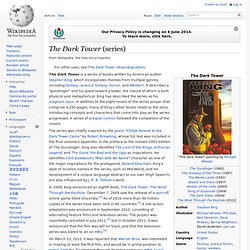
In the preface to the revised 2003 edition of The Gunslinger, King also identifies The Lord of the Rings, Arthurian Legend, and The Good, the Bad and the Ugly as inspirations. He identifies Clint Eastwood's "Man with No Name" character as one of the major inspirations for the protagonist, Roland Deschain. King's style of location names in the series, such as Mid-World, and his development of a unique language abstract to our own (High Speech), are also influenced by J. R. R. On March 13, 2012, it was reported that Warner Bros. was interested in making at least the first film, and would be in prime position to green-light the TV element through its sister company, HBO. Childe Roland to the Dark Tower Came. Childe Roland to the Dark Tower Came painted by Thomas Moran in 1859.
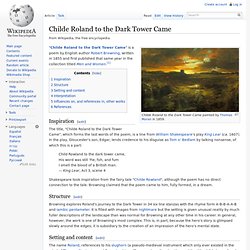
Inspiration[edit] The title, "Childe Roland to the Dark Tower Came", which forms the last words of the poem, is a line from William Shakespeare's play King Lear (ca. 1607). In the play, Gloucester's son, Edgar, lends credence to his disguise as Tom o' Bedlam by talking nonsense, of which this is a part: Child Rowland to the dark tower came, His word was still 'Fie, foh, and fum I smell the blood of a British man. — King Lear, Act 3, scene 4 Shakespeare took inspiration from the fairy tale "Childe Rowland", although the poem has no direct connection to the tale.
Structure[edit] Browning explores Roland's journey to the Dark Tower in 34 six line stanzas with the rhyme form A-B-B-A-A-B and iambic pentameter. Childe Rowland. "Childe Rowland" is a fairy tale, the most popular version being by Joseph Jacobs in his English Folk and Fairy Tales, published in 1892.
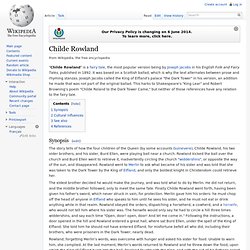
It was based on a Scottish ballad, which is why the text alternates between prose and rhyming stanzas. Joseph Jacobs called the King of Elfland's palace "the Dark Tower" in his version, an addition he made that was not part of the original ballad. This harks to Shakespeare's "King Lear" and Robert Browning's poem "Childe Roland to the Dark Tower Came," but neither of those references have any relation to the fairy tale. Synopsis[edit] The eldest brother decided he would make the journey, and was told what to do by Merlin. Rowland, forgetting Merlin's words, was overcome with hunger and asked his sister for food. Cultural influences[edit] The synopsis of Childe Rowland is found in a Scandinavian medieval ballad.
"Childe Rowland" is referenced briefly in King Lear, by Gloucester's son, Edgar, disguised as mad Tom, in one of his mad ramblings: Nebula Award Winners and Hugo Award Winners for Best Novel on AbeBooks. The Hugo Awards and the Nebula Awards are the traditional yardsticks for fantasy and science fiction writing and have been for decades.
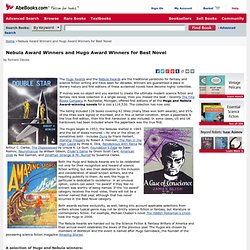
Winners are guaranteed a place in literary history and first editions of these acclaimed novels have become highly collectible. If money was no object and you wanted to create the ultimate modern science fiction and fantasy rare book collection in a single swoop, then you missed the boat - recently The Fine Books Company in Rochester, Michigan, offered first editions of all the Hugo and Nebula Award-winning novels for a cool $116,530. The collection has now sold. The listing included 126 books covering 82 titles (many titles won both awards), and 95% of the titles were signed or inscribed, and in fine or better condition. When a paperback is the true first edition, then the first hardcover is also included.
A selection of Hugo and Nebula winners: Nebula Novel Winners 1965 - Dune by Frank Herbert. Comic science fiction. Comic science fiction is a sub-genre of soft science fiction or science fantasy that exploits the genre's conventions for comedic effect.
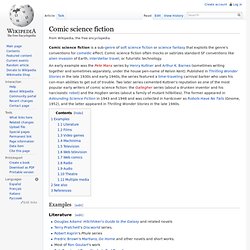
Comic science fiction often mocks or satirizes standard SF conventions like alien invasion of Earth, interstellar travel, or futuristic technology. An early example was the Pete Manx series by Henry Kuttner and Arthur K. Barnes (sometimes writing together and sometimes separately, under the house pen-name of Kelvin Kent). Published in Thrilling Wonder Stories in the late 1930s and early 1940s, the series featured a time-traveling carnival barker who uses his con-man abilities to get out of trouble. Two later series cemented Kuttner's reputation as one of the most popular early writers of comic science fiction: the Gallegher series (about a drunken inventor and his narcissistic robot) and the Hogben series (about a family of mutant hillbillies).
Examples[edit] Literature[edit] Films[edit] Video games[edit] Machinima[edit] Red vs.